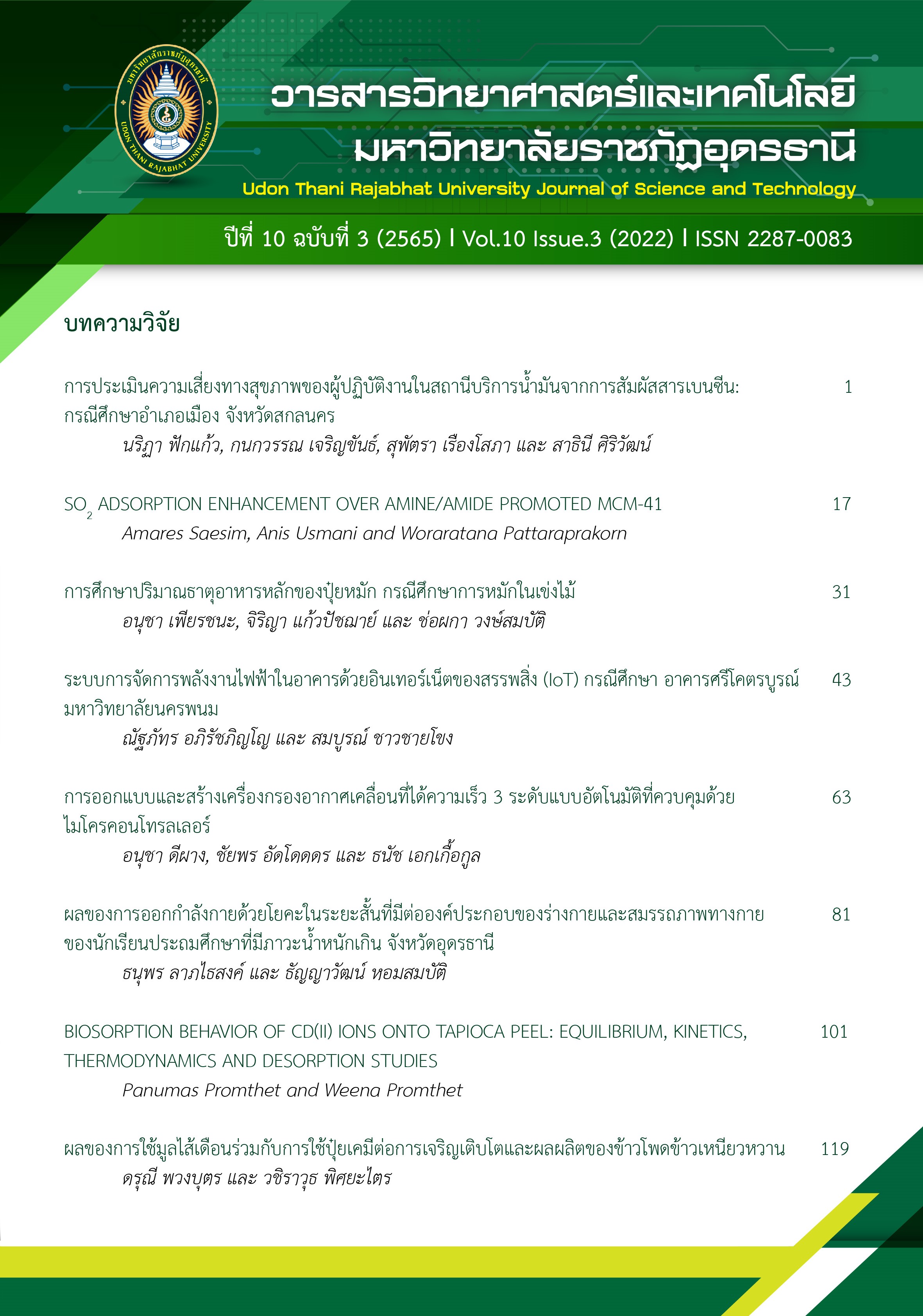SO2 ADSORPTION ENHANCEMENT OVER AMINE/AMIDE PROMOTED MCM-41
Main Article Content
บทคัดย่อ
Amine/amide-support mesoporous material has been proven to enhance the acidic gas uptake. Herein, MCM-41 synthesized from rice-husk (RH) was employed as a molecular sieve supporter for dynamic SO2 adsorption. Four species of classified amine/amide including urea (U), monoethanolamine (MEA), triethylenetetramine (TETA), and dimethylformamide (DMF) were comparatively impregnated with RM. The SO2 adsorption was carried out in a fixed bed column at 42,000 hr-1 WHSV. DMF impregnated RM (DMF-RM) provided higher uptake capacity than other impregnated RMs. The SO2 favors adsorbed on tertiary amine/ amide rather than primary and secondary ones. The higher DMF content could enhance SO2 adsorbability. The condition ranges of using 3%wt of DMF loading, initial concentration of SO2 in synthetic waste gas less than 120 ppm, and room temperature up to 60oC provided the optimal adsorption capacity toward SO2. The regeneration of adsorbent performed completely at moderate temperature of 200oC. DMF-RM showed 4% capacity declination after 8 cycles consecutively uses.
Article Details
เอกสารอ้างอิง
Aaron, D., & Tsouris, C. (2005). Separation of CO2 from flue gas: a review. Separation Science and Technology, 40, 321-348.
Abdulrasheed, A. A., Jalil, A. A., Triwahyono, S., Zaini, M. A. A., Gambo, Y., & Ibrahim, M. (2018). Surface modification of activated carbon for adsorption of SO2 and NOX: a review of existing and emerging technologies. Renewable and Sustainable Energy Reviews, 94, 1067-1085.
Areerob, T., Grisdanurak, N., & Chiarakorn, S. (2011). Improvement of BTEX adsorption using silylated RH-MCM-41 synthesized from rice husk silica. Materials Science Forum, 700, 231-235.
Berger, M., Dorge, S., Nouali, H., Habermacher, D., Fiani, E., Vierling, M., Molière, M., Brilhac, J. F., & Patarin, J. (2018). Role of the process conditions on the sulphation and stability of a CuO/SBA-15 type SOx adsorbent in cycling operations. Chemical Engineering Journal, 350, 729-738.
Bhagiyalakshmi, M., Yun, L. J., Anuradha, R., & Jang, H. T. (2010). Utilization of rice husk ash as silica source for the synthesis of mesoporous silicas and their application to CO2 adsorption through TREN/TEPA grafting. Journal of Hazardous Materials, 175, 928-938.
Dhokte, A. O., Khillare, S. L., Lande, M. K., & Arbad, B. R. (2011). Synthesis, characterization of mesoporous silica materials from waste coal fly ash for the classical Mannich reaction. Journal of Industrial and Engineering Chemistry, 17, 742-746.
Diaf, A., & Beckman, E. J. (1995). Thermally reversible polymeric sorbents for acid gases, IV. Affinity tuning for the selective dry sorption of NOx. Reactive Polymers, 25, 89-96.
Gang, L., Shaoguang, H., & Qian, K. (2022). A promoted mesoporous silica-based material for SO2 adsorption. Silicon, 14, 2225–2233.
Hanif, M. A., Ibrahim, N., Isa, K. M., & Jalil, A. A. (2020). Application of mesoporous silica as catalyst support in sulfur dioxide removal: metal and amine sorbent modifications. In: Proceedings of 2nd Joint Conference on Green Engineering Technology & Applied Computing 2020, 4-5 February, 2020, Bangkok, Thailand. Doi 10.1088/1757-899X/864/1/012131.
Kumar, P., Mal, N., Oumi, Y., Yamana, K., & Sano, T. (2001). Mesoporous materials prepared using coal fly ash as the silicon and aluminium source. Journal of Material Chemistry A, 11, 3285-3290.
Kylhammar, L., Carlsson, P. A., Ingelsten, H. H., Grönbeck, H., & Skoglundh, M. (2008). Regenerable ceria-based SOx traps for sulfur removal in lean exhausts. Applied Catalysis B: Environmental, 84, 268-276.
Li, G., Wang, B., Sun, Q., Xu, W. Q., & Han, Y. (2017). Adsorption of lead ion on amino-functionalized fly-ash-based SBA-15 mesoporous molecular sieves prepared via two-step hydrothermal method. Microporous and Mesoporous Materials, 252, 105-115.
Rahmaninejad, F., Gavaskar, V. S., & Abbasian, J. (2012). Dry regenerable CuO/ γ-Al2O3 catalyst for simultaneous removal of SOx and NOx from flue gas. Applied Catalysis B: Environmental, 119-120, 297-303.
Tailor, R., & Sayari, A. (2016). Grafted propyldiethanolamine for selective removal of SO2 in the presence of CO2. Chemical Engineering Journal, 289, 142-149.
Tailor, R., Abboud, M., & Sayari, A. (2014). Supported polytertiary amines: highly efficient and selective SO2 adsorbents. Environmental Science & Technology, 48, 2025-2034.
Uyanga, I. J., & Idem, R. O. (2007). Studies of SO2- and O2-induced degradation of aqueous MEA during CO2 capture from power plant flue gas streams. Industrial & Engineering Chemistry Research, 46, 2558-2566.
Wang, X., Ma, X., Zhao, S., Wang, B., & Song, C. (2009). Nanoporous molecular basket sorbent for NO2 and SO2 capture based on a polyethylene glycol-loaded mesoporous molecular sieve. Energy & Environmental Science Journal, 2, 878-882.
Xu, Q., Jiang, W., Xiao, J., & Wei, X. (2019). Absorption of sulfur dioxide by tetraglyme–sodium salt ionic liquid. Molecules, 24, 436.
Xu, X., Song, C., Miller, B. G., & Scaroni, A. W. (2005). Adsorption separation of carbon dioxide from flue gas of natural gas-fired boiler by a novel nanoporous “molecular basket” adsorbent. Fuel Processing Technology, 86, 1457-1472.
Yu, X., Hao, J., Xi, Z., Liu, T., Lin, Y., & Xu, B. (2019). Investigation of low concentration SO2 adsorption performance on different amine-modified merrifield resins. Atmospheric Pollution Research, 10, 404-411.
Zhi, Y., Zhou, Y., Su, W., Sun, Y., & Zhou, L. (2011). Selective adsorption of SO2 from flue gas on triethanolamine-modified large pore SBA-15. Industrial & Engineering Chemistry Research, 50, 8698-8702.


